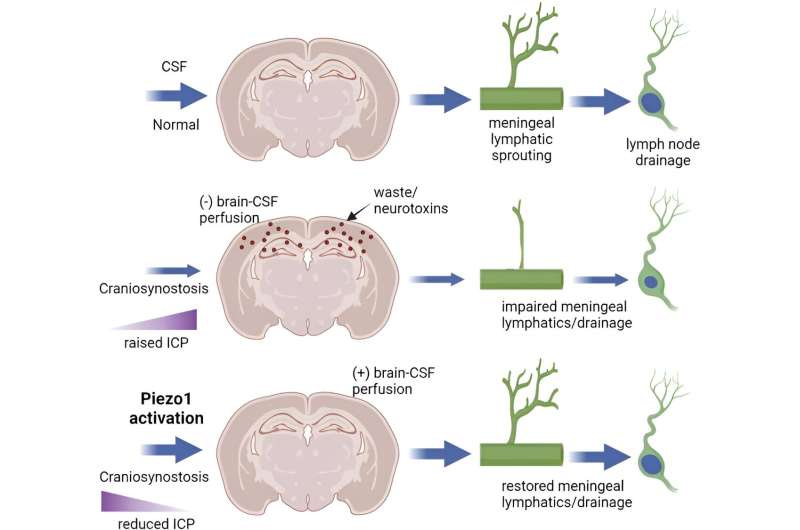This article has been reviewed according to Science X's editorial process and policies. Editors have highlighted the following attributes while ensuring the content's credibility:
fact-checked
trusted source
proofread
Drug repairs systems that remove Alzheimer's-causing waste from the brain, study shows

A team of Rutgers undergraduates has shown that an experimental drug known as Yoda1 may help drain cranial waste plus neurotoxins that cause Alzheimer's disease and other forms of dementia.
"The brain's lymphatic system is one of the hottest research areas in all of medicine right now because it has only been re-discovered in the past ten years, and it's clearly vital to healthy brain function and, very likely, developing dementias like Alzheimer's," said Max Tischfield, a resident scientist at the Child Health Institute of New Jersey at Rutgers Robert Wood Johnson Medical School and an assistant professor of cell biology and neuroscience at Rutgers University-New Brunswick.
"The team for this study took a very out-of-the-box approach and studied a human cranial facial disorder called craniosynostosis that creates excess pressure inside the skull," added Tischfield, the senior author of the study, who conducted the research with honors undergraduate students from the departments of Genetics and Cell Biology and Neuroscience.
"We started by showing this extra pressure damaged the brain's lymphatic system, inhibiting cerebrospinal fluid movement and thus the ability to drain waste. We then went on to find a way to prevent and even partially reverse the problem."
The study, published in the Journal of Clinical Investigation, examined mice with craniosynostosis, a skull malformation that increases pressure inside the skull and reduces the ability to form, maintain and use the network of lymphatic vessels that help drain brain waste and plaque-laden cerebrospinal fluid. In addition, the ability of cerebrospinal fluid to perfuse into the brain and clear waste to surrounding lymphatic vessels, known as the glymphatic system, was impeded.
Using a mouse model for familial Alzheimer's disease, the addition of craniosynostosis and associated impairments to the lymphatic and glymphatic systems caused a significant increase in plaque burden in the brain.
To counteract these deficits, the investigators turned their attention to a drug called Yoda1, which activates a force-sensing ion channel known as Piezo1. This drug reduced intracranial pressure and allowed newborn mice with craniosynostosis to develop and maintain normal lymphatic vasculature that supported the ability of cerebrospinal fluid to perfuse into the brain and drain its waste to lymph nodes.
Researchers also found that using Yoda1 in previously untreated aged adult mice improved meningeal lymphatic and glymphatic functions, making brain waste-clearance systems that had looked old appear young again.
Both the brain's associated lymphatic system and the existence of Piezo mechanosensitive ion channels are recent discoveries that have generated excitement and research.
Despite dissecting millions of brains over the past few millennia, the existence of lymphatic vessels to drain brain waste products was overlooked until 2015, when a team led by Washington University neuroscientist Jonathan Kipnis reported the brain's lymphatic system in a paper in Nature. A separate team led by Kari Alitalo at the University of Helsinki also reported the discovery of these vessels in the Journal of Experimental Medicine. Subsequent research has found that lymphatic waste removal may play a significant role in the development of Alzheimer's.
Yoda1 has yet to undergo human trials, but researchers everywhere are seeking effective Alzheimer's treatments. The degenerative disease, along with other forms of dementia, is becoming more common as the American population ages.
"Many labs are working in this space because there's still so much to learn about the lymphatic system that surrounds the brain," Tischfield said. "There's particular excitement because research to date has found that it degenerates dramatically with age, so any breakthrough that maintains its function might help prevent age-related cognitive decline."
"The next step for us in this line of research is to discover the mechanism Yoda1 uses to improve vessel function,"' he added. "Is it working directly on the vessels by stimulating Piezo1, stimulating a growth factor in the environment or doing something else?"
More information: Matt J. Matrongolo et al, Piezo1 agonist restores meningeal lymphatic vessels, drainage, and brain-CSF perfusion in craniosynostosis and aged mice, Journal of Clinical Investigation (2023). DOI: 10.1172/JCI171468


















